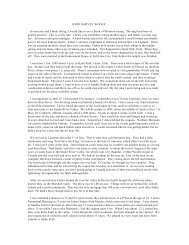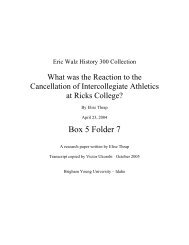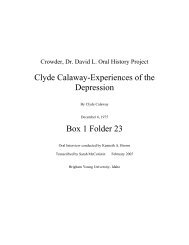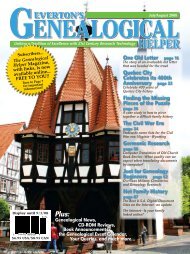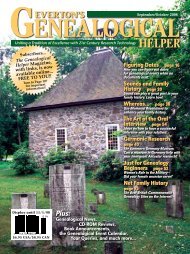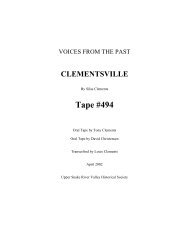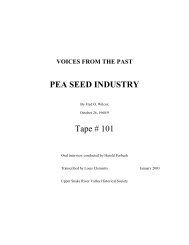HelPeR - BYU Idaho Special Collections and Family History
HelPeR - BYU Idaho Special Collections and Family History
HelPeR - BYU Idaho Special Collections and Family History
Create successful ePaper yourself
Turn your PDF publications into a flip-book with our unique Google optimized e-Paper software.
Ancestor Stories for the Soul<br />
combat as an infantryman, as had John. I felt a bond<br />
forming between us as so often occurs between soldiers.<br />
Corny as it may sound, it was very real to me.<br />
And this is the point at which I thought the information<br />
stopped. I assumed that he became one of the<br />
approximately 300,000 Civil War dead whose bodies<br />
were placed in various national cemeteries after the<br />
War, 54 percent of which are listed as “Unknown.” I<br />
assumed that John was one of these Unknowns.<br />
How It Continued (the Later Years)<br />
Time passed <strong>and</strong> then it was late in 2003. I was attending<br />
a computer special interest group (called a<br />
“SIG” by those in the computer world). This particular<br />
group focused on using the Internet for genealogy.<br />
The leader proved himself as helpful as he was<br />
knowledgeable. When I mentioned my ancestor John<br />
<strong>and</strong> Vicksburg, he set off to find if he was buried<br />
there. We discovered that some cemeteries are administered<br />
by Veteran’s Affairs, <strong>and</strong> some fall under the<br />
National Park Service. The latter has responsibility<br />
for the National Cemetery at Vicksburg because the<br />
site is classified as a National Military Park.<br />
After some searching around on the Internet, we<br />
found the information we were looking for: a grave<br />
number for John. I was flabbergasted! There was yet<br />
more to the quest than I had imagined! And little did<br />
I know at that time how exceptional it was for the<br />
specific location of John’s grave to be known. That<br />
was truly the exception rather than the rule at Vicksburg.<br />
I vowed to go there.<br />
How it Ended (Vicksburg)<br />
It was now the summer of the next year, 2004. My<br />
wife <strong>and</strong> I were taking a trip<br />
through the Midwest <strong>and</strong> on the<br />
way back home to Florida made<br />
good on my vow: we stopped at<br />
Vicksburg with the intent of finding<br />
John’s grave.<br />
A short history of the battle of<br />
Vicksburg may be of value here.<br />
It was a siege, actually, that lasted<br />
47 days (from late May to early<br />
July of 1863), <strong>and</strong> was punctuated<br />
with nearly constant fights <strong>and</strong><br />
skirmishes between the Union<br />
<strong>and</strong> Rebel forces. Based on John’s<br />
date of death, it was one of these<br />
Union assaults during which he<br />
was killed.<br />
The Military Park itself surrounds<br />
the city of Vicksburg,<br />
much as the Union forces did in<br />
the summer of 1863. One end of<br />
the park is anchored on the Mississippi River south<br />
of the city. It runs east <strong>and</strong> north in almost a perfect<br />
semicircle to terminate at the river north of the city.<br />
A one-way road follows the outside of that semicircle<br />
from south to north past the location of the Union<br />
forces, <strong>and</strong> then doubles back concentrically on the<br />
inside of the semicircle to trace the locations of the<br />
Confederate forces.<br />
The terrain is rough, following high bluffs above<br />
the city, <strong>and</strong> is cut by severe gorges caused by drainage<br />
to the river below. That terrain is cut again by the<br />
remnants of trenches <strong>and</strong> barriers erected for protection,<br />
assault, <strong>and</strong> defense. To the casual observer<br />
the ground today is simply rough <strong>and</strong> wooded <strong>and</strong><br />
beautiful; to the person with some military experience,<br />
the importance of terrain to tactics <strong>and</strong> strategy<br />
is undeniable. One can see why the siege lasted as<br />
long as it did; how the ground favors defense; how<br />
the Union troops had to fight the rugged terrain as<br />
well as the Confederate defenders.<br />
A tape is available to guide the visitor along the<br />
park road <strong>and</strong> explain the events that occurred there.<br />
Should you visit the battlefield, I highly recommend<br />
the tape. It takes you beyond the simple but undeniable<br />
beauty of the park to the human struggle that<br />
took place. It makes the ground “come alive” as it<br />
describes various clashes <strong>and</strong> feats of heroism <strong>and</strong><br />
futility alike.<br />
Each state with sons who fought there has erected<br />
a monument to them. There are large state monuments,<br />
some actually entire buildings, as well as<br />
smaller markers to show where individual units<br />
were located in the line. All told, there are over 1300<br />
historic monuments <strong>and</strong> markers.<br />
Ja n ua ry/Fe b r u a r y 2009 Ev e r t o n’s Ge n e a l o g i c a l He l p e r © 53



